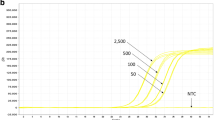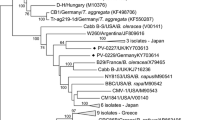Abstract
In 2003 the European Commission introduced a 0.9 % threshold for food and feed products containing genetically modified organism (GMO)-derived components. For commodities containing GMO contents higher than this threshold, labelling is mandatory. To provide a DNA-based rapid and simple detection method suitable for high-throughput screening of GMOs, several isothermal amplification approaches for the 35S promoter were tested: strand displacement amplification, nicking-enzyme amplification reaction, rolling circle amplification, loop-mediated isothermal amplification (LAMP) and helicase-dependent amplification (HDA). The assays developed were tested for specificity in order to distinguish between samples containing genetically modified (GM) maize and non-GM maize. For those assays capable of this discrimination, tests were performed to determine the lower limit of detection. A false-negative rate was determined to rule out whether GMO-positive samples were incorrectly classified as GMO-negative. A robustness test was performed to show reliable detection independent from the instrument used for amplification. The analysis of three GM maize lines showed that only LAMP and HDA were able to differentiate between the GMOs MON810, NK603, and Bt11 and non-GM maize. Furthermore, with the HDA assay it was possible to realize a detection limit as low as 0.5 %. A false-negative rate of only 5 % for 1 % GM maize for all three maize lines shows that HDA has the potential to be used as an alternative strategy for the detection of transgenic maize. All results obtained with the LAMP and HDA assays were compared with the results obtained with a previously reported real-time PCR assay for the 35S promoter in transgenic maize. This study presents two new screening assays for detection of the 35S promoter in transgenic maize by applying the isothermal amplification approaches HDA and LAMP.

Similar content being viewed by others
References
European Council (1998) Council Regulation (EC) No. 1139/98 concerning the compulsory indication of the labelling of certain foodstuffs produced from genetically modified organisms of particulars other than those provided for in Directive 79/112/EEC. Off J Eur Communities L 159:4–7
European Commission (2000) Commission Regulation (EC) No 49/2000 of 10 January 2000 amending Council Regulation (EC) No 1139/98 concerning the compulsory indication on the labelling of certain foodstuffs produced from genetically modified organisms of particulars other than those provided for in Directive 79/112/EEC. Off J Eur Communities L 6:13–14
GMOMETHODS: EU database of reference methods for GMO analysis () Joint Research Centre, European Union Reference Laboratory for GM Food and Feed. http://gmo-crl.jrc.ec.europa.eu/gmomethods/
Odell JT, Nagy F, Chua NH (1985) Identification of DNA sequences required for activity of the cauliflower mosaic virus 35S promoter. Nature 313:810–812
Nagy F, Odell JT, Morelli G, Chua NH (1985) Properties of expression of the 35S promoter from CaMV in transgenic tobacco plants. In: Zaitlin M, Day P, Hollaender A, Wilson CM (eds) Biotechnology in plant science: Relevance to agriculture in the eighties. Academic, Orlando, pp 227–235
Benfey PN, Ren L, Chua NH (1989) The CaMV 35S enhancer contains at least two domains which can confer different developmental and tissue-specific expression patterns. EMBO J 8(8):2195–2202
Scholtens I, Laurensse E, Molenaar B, Zaaijer S, Gaballo H, Boleij P, Bak A, Kok E (2013) Practical experiences with an extended screening strategy for genetically modified organisms (GMOs) in real-life samples. J Agric Food Chem 61:9097–9109
Paszkowski J, Baur M, Bogucki A, Potrykus I (1988) Gene targeting in plants. EMBO J 7(13):4021–4026
Scientific Panel on Genetically Modified Organisms (2009) Applications (EFSA-GMO-RX-MON810) for the renewal of authorisation for the continued marketing of (1) existing food and food ingredients produced from genetically modified insect resistant maize MON810; (2) feed consisting of and/or containing maize MON810, including the use of seed for cultivation; and of (3) food and feed additives, and feed materials produced from maize MON810, all under Regulation (EC) No 1829/2003 from Monsanto. EFSA J 1149:1–84
European Network of GMO Laboratories (2008) Definition of minimum performance requirements for analytical methods of GMO testing. Community Reference Laboratory for GM Food and Feed, Ispra
Aliotta JM, Pelletier JJ, Ware JL, Moran LS, Brenner JS, Kong H (1996) Thermostable Bst DNA polymerase I lacks a 3’→5’ proofreading exonuclease activity. Genet Anal 12(5–6):185–195
Iwamoto T, Sonobe T, Hayashi K (2003) Loop-mediated isothermal amplification for direct detection Mycobacterium tuberculosis complex, M. avium, and M. intracellulare in sputum samples. J Clin Microbiol 41(6):2616–2622
Walker GT, Little MC, Nadeau JG, Shank DD (1992) Isothermal in vitro amplification of DNA by a restriction enzyme/DNA polymerase system. Proc Natl Acad Sci U S A 89:392–396
Walker GT, Fraiser MS, Schram JL, Little MC, Nadeau JG, Malinowski DP (1992) Strand displacement amplification—an isothermal, in vitro DNA amplification technique. Nucleic Acids Res 20:1691–1696
Spargo CA, Fraiser MS, Van Cleve M, Wrigth DJ, Nycz CM, Spears PA, Walker GT (1996) Detection of M. tuberculosis DNA using thermophilic strand displacement amplification. Mol Cell Probes 10:247–256
Ehses S, Ackermann J, McCaskill JS (2005) Optimization and design of oligonucleotide setup for strand displacement amplification. J Biochem Biophys Methods 63:170–186
Joneja A, Huang X (2011) Linear nicking endonuclease-mediated strand-displacement DNA amplification. Anal Biochem 414:58–69
Fire A, Xu S (1995) Rolling circle replication of short DNA circles. Proc Natl Acad Sci U S A 92(10):4641–4645
Lizardi P, Huang X, Zhu Z, Bray-Ward P, Thomas D, Ward D (1998) Mutation detection and single-molecule counting using isothermal rolling-circle amplification. Nat Genet 19:225–232
Notomi T, Okayama H, Masubuchi H, Yonekawa T, Watanabe K (2000) Loop-mediated isothermal amplification of DNA. Nucleic Acids Res 28(12):I–VII
Nagamine K, Hase T, Notomi T (2002) Accelerated reaction by loop-mediated isothermal amplification using loop primers. Mol Cell Probes 16:223–229
Vincent M, Xu Y, Kong H (2004) Helicase-dependent isothermal DNA amplification. EMBO Rep 5(8):795–800
Kim J, Easley CJ (2011) Isothermal DNA amplification in bioanalysis: strategies and applications. Bioanalysis 3(2):227–239
Waiblinger HU, Ernst B, Anderson A, Pietsch K (2008) Validation and collaborative study of a P35S and T-nos duplex real-time PCR screening method to detect genetically modified organisms in food products. Eur Food Res Technol 226:1221–1228
Kiddle G, Hardinge P, Buttigieg N, Gandelman O, Pereira C, McElgunn CJ, Rizzoli M, Jackson R, Appleton N, Moore C, Tisi LC, Murray JAH (2012) GMO detection using a bioluminescent real time reporter (BART) of loop mediated isothermal amplification (LAMP) suitable for field use. BMC Biotechnol 12:15
Lee D, La Mura M, Allnutt TR, Powell W (2009) Detection of genetically modified organisms (GMOs) using isothermal amplification of target DNA sequences. BMC Biotechnol 9:7
Shrestha HK, Hwu KK, Wang SJ, Liu LF, Chang MC (2008) Simultaneous detection of eight genetically modified maize lines using a combination of event- and construct-specific multiplex-PCR technique. J Agric Food Chem 56:8962–8968
Joint Research Centre (2007) Maize seeds sampling and DNA extraction. Report on the validation of a DNA extraction method from maize seeds and grains. Community Reference Laboratory for GM Food and Feed, Ispra, http://gmo-crl.jrc.ec.europa.eu/summaries/3272_DNAExtrReport.pdf. Accessed 18 Apr 2007
Kuribara H, Shindo H, Matsuoka T, Takubo K, Futo S, Aoki N, Hirao T, Akiyama H, Goda Y, Toyoda M (2002) Novel reference molecules for quantitation of genetically modified maize and soybean. J AOAC Int 85(5):1077–1089
Matsuoka T, Kuribara H, Takubo K, Akiyama H, Miura H, Goda Y, Kusakabe Y, Isshiki K, Toyoda M, Hino A (2002) Detection of recombinant DNA segments introduced to genetically modified maize (Zea mays). J Agric Food Chem 50:2100–2109
Monis PT, Giglio S, Saint CP (2005) Comparison of SYTO9 and SYBR Green I for real-time polymerase chain reaction and investigation of the effect of dye concentration on amplification and DNA melting curve analysis. Anal Biochem 340(1):24–34
Pang S, Qureshi F, Shanahan D, Harris N (2007) Investigation of the use of rolling circle amplification for the detection of GM food. Eur Food Res Technol 225:59–66
Hadersdorfer J (2012) Development of an isothermal nucleic acid amplification protocol for high-throughput monitoring of Plum pox virus infection in stone fruit production. Doctoral thesis, Technische Universität München, Munich
Acknowledgments
This work was supported by the state of Lower Austria in cooperation with the European Regional Development Fund.
Author information
Authors and Affiliations
Corresponding author
Additional information
Published in the topical collection Advanced Food Analysis with guest editors Michel W.F. Nielen, Jana Hajslova, and Rudolf Krska.
Celine Zahradnik and Claudia Kolm contributed equally.
Electronic supplementary material
Below is the link to the electronic supplementary material.
ESM 1
(PDF 528 kb)
Rights and permissions
About this article
Cite this article
Zahradnik, C., Kolm, C., Martzy, R. et al. Detection of the 35S promoter in transgenic maize via various isothermal amplification techniques: a practical approach. Anal Bioanal Chem 406, 6835–6842 (2014). https://doi.org/10.1007/s00216-014-7889-2
Received:
Revised:
Accepted:
Published:
Issue Date:
DOI: https://doi.org/10.1007/s00216-014-7889-2




